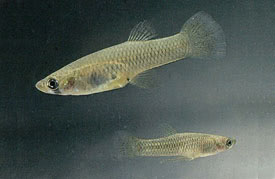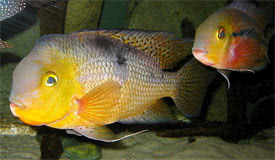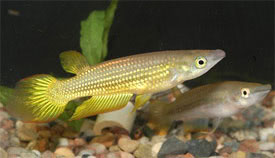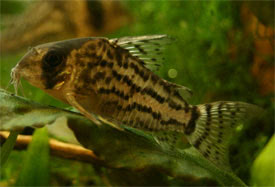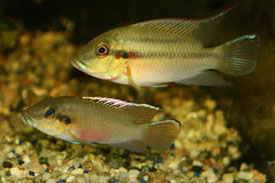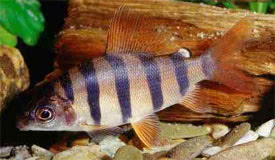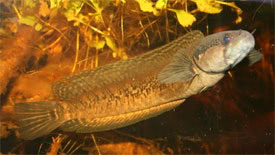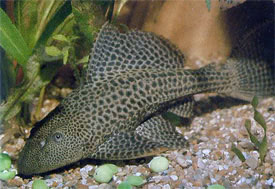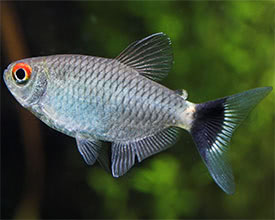Leiarius pictus - Sailfin Pim
 Magyarul / Hungarian
Magyarul / Hungarian

 Magyarul / Hungarian
Magyarul / Hungarian
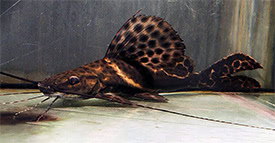
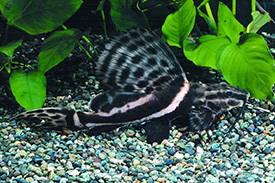
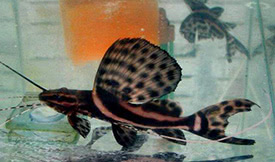

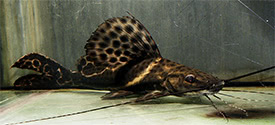
- Scientific name: Leiarius pictus
- Synonyms: Bagrus pictus (Müller & Troschel, 1849), Sciades pictus (Müller & Troschel, 1849)
- Common name: Sailfin Pim
- Group: Catfish
- Distribution: South America; Native to the Rio Orinoco basin in Colombia and Venezuela, and parts of the Amazon drainage in Peru and Brazil.
- Size: 60 cm
- Biotope: Inhabits large rivers and lakes. They usually rest among submerged tree roots and other refuges during the day, and emerging at night to feed.
- Social behavior: Quite peaceful catfish, but they will eat smaller tank mates. Can be kept with similarly sized fish, but it is territorial towards both conspecifics and other large Pimelodids, so it is best to keep it alone.
- Diet: Carnivorous; In nature it mostly eat fish, but in the aquarium it usually adapts well to meaty foods such as mussels, fish and earthworms. Try not to overfeed them, because this can lead to health problems in the long term.
- Breeding: Not successful in aquarium.
- Tank: Minimum 2500 litres
- Population: 1 fish for 2500 litres
- Decoration: The species needs a dimly lighted aquarium with lots of swimming space and some hiding places. The tank can also be docorated with tree branches and roots. The substrate should be fine sand, or leave the substrate out altogether, which makes cleaning the tank an easier task. It is advisable to build a sump filter under the main aquarium as this allows most of the equipment to be located outside the tank, because the fish can easily destroy glass heaterstats, or thermometers.
- Temperature: 22-26 °C
- pH: 6.2-7.6
- Hardness: 5.0-18.0 dGH
- Lifespan: 15-20 years
Description: Sailfin Pim has a dark brown body with darker spots, while the underside has lighter coloration. The catfish has two pale bands, which are more noticeable in juvenile specimens, the first extends from the base of the dorsal fine spine toward the ventral fin, and then laterally along the body to the caudal fin base. The second thinner band lies parallel to the first originating from the base of the third to sixth soft dorsal fin rays. The head is narrow, flattish from above, and the upper jaw is slightly longer than the lower. As its name suggests Sailfin Pim has large sail-like dorsal fin with large round dusky spots. The adipose and caudal fins also have these large spots, while the anal and ventral fins are covered with smaller spots.
A quite intelligent catfish, and will develop a real personality as it grows. Sailfin Pim has an amazing set of very long barbels that can move independently of each other, and this is why the fish needs a wide tank, as it can become stressed if there isn't enough room to extend them fully. They need a huge aquarium, something in the region of 240x120x90 cm would be needed for a fully-grown fish. Because of its adult size, this catfish should not be considered as a home aquarium fish, unless we are talking about a huge tank, and in addition they grow quite quickly. It's also worth noting that this catfish can live for well over 20 years, making it a considerable long term commitment. Therefore only those aquarists should buy this catfish, who already have the resources requires to house it.
It is almost impossible to sex them by external characteristics, although adult female might has stockier body.
There are no reports of their successful breeding in home aquariums.
Sources:
https://www.fishbase.se/summary/48541
https://www.seriouslyfish.com/species/leiarius-pictus
https://www.planetcatfish.com/common/species.php?species_id=290
https://www.scotcat.com/factsheets/leiarius_pictus.htm
https://www.fishbase.se/summary/48541
https://www.seriouslyfish.com/species/leiarius-pictus
https://www.planetcatfish.com/common/species.php?species_id=290
https://www.scotcat.com/factsheets/leiarius_pictus.htm
Hasonló vízparamétereket igénylő fajok




